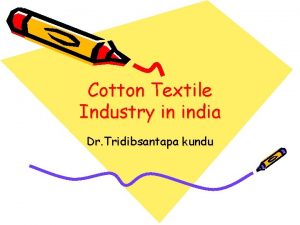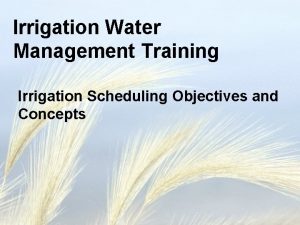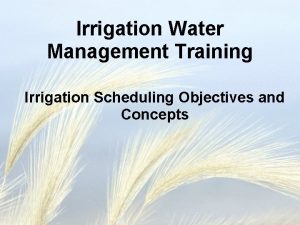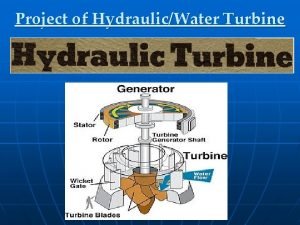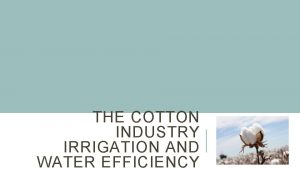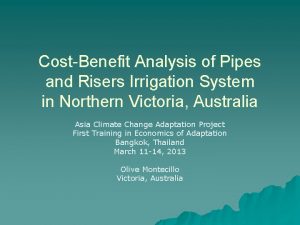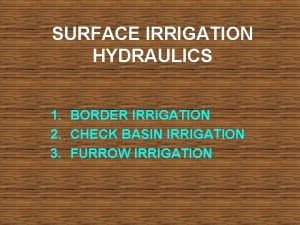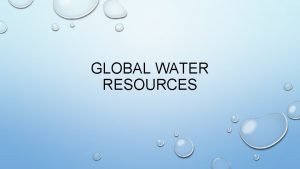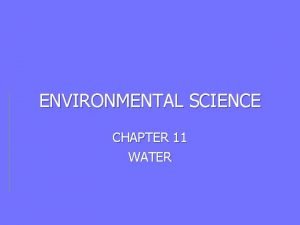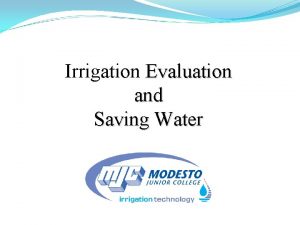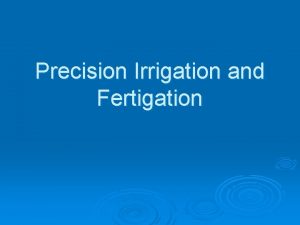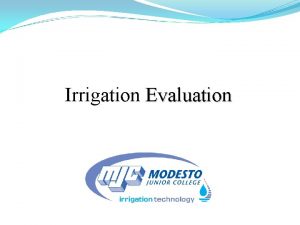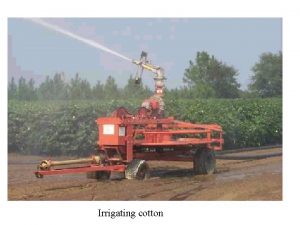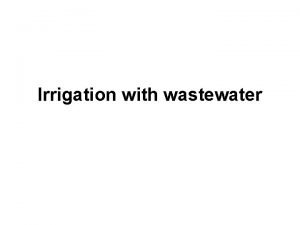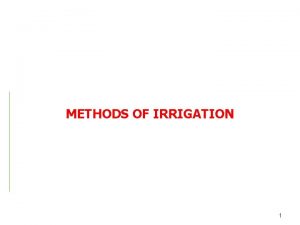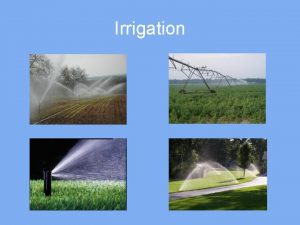THE COTTON INDUSTRY IRRIGATION AND WATER EFFICIENCY WHAT

















- Slides: 17

THE COTTON INDUSTRY IRRIGATION AND WATER EFFICIENCY

WHAT IS IRRIGATION? Irrigation is the mechanical movement of water which is used to take water to plants and crops, usually for the use of agriculture. Irrigation is used to assist in the growing of crops in dry areas when periods of insufficient rainfall occur. Majority of cotton crops rely on irrigation water, this is a major component of growing a cotton crop and it significantly helps produce a higher quality yield.

TYPES OF IRRIGATION – SUBSURFACE DRIP (SDI) Subsurface drip irrigation is particularly used in regions where it gets extremely hot and the soil is sandy. This is because water evaporates very quickly. SDI is a highly water efficient irrigation system which ensures that the application of water is used directly at the plant root. Drip infrastructure is buried beneath the surface of paddocks at a level that is deep enough not to be disturbed by cultivation machines.

CENTRE PIVOTS/LATERAL MOVE IRRIGATORS (CPLM) Centre pivot and lateral move systems are self-propelled irrigation systems which apply water generally from above the canopy, to pasture or crop. They are less labour intensive than other irrigation systems, although the capital cost is much higher. CPLM systems require an energy source that can move the machine on the farm but also move the water to the plant. They can be very water efficient and last up to 20 years.

FURROW IRRIGATION Furrow irrigation continues to be the most dominant irrigation method in the Australian Cotton Industry because of its efficiency and cost value. The furrows are small, parallel channels which run between each row of crop and carry water down to each plant. Approximately 60 to 70 percent of water is used by the crop; the rest is recycled as run-off or lost to deep drainage, and this is a steep advance compared to past years after extensive efforts to improve its performance.

ADVANTAGES & DISADVANTAGES OF IRRIGATION METHODS IRRIGATION METHOD ADVANTAGES Subsurface Drip (SDI) • • Better rainfall capture Reduced soil surface evaporation Able to control water runoff Better fertiliser efficiency Reduced growth of disease and weeds Lower labour demands May increase yield Furrow • • • Lower initial cost of equipment Smaller pumping costs Proper practise can minimise irrigation costs May lead to higher crop yields Less chemical leaching DISADVANTAGES • • • Must follow strict guidelines to ensure a profit (design, installation, maintenance, etc. ) If guidelines are not practised, yield and profit will be reduced. Costs are much greater compared to other techniques. Greater labour costs Lower application efficiency compare to other techniques Soil erodes must quicker than other methods

ADVANTAGES & DISADVANTAGES IRRIGATION METHOD ADVANTAGES • • • CPLM • • • Less labour intensive than other techniques Lower soil tillage and water runoff Drop nozzles in the centre pivot system can be set close to ground level Water coverage under the centre pivot is very even Nozzles are designed to rarely get clogged They can last for up to 20 years DISADVANTAGES • • • Capital cost (especially for a ‘site specific system design) Greater chance of evaporation and wind drift Not suitable for square or rectangular paddocks High maintenance cost Trees have to be removed increasing erosion It can take several years to receive the best performance

BANKLESS SUPPLY CHANNELS Bankless supply channels have the channel dug below the surface of the ground and the baks at the side of the channel are at ground height, so no actual banks are needed to keep the water in the channel. This stops channel blowouts and water losses. They are highly maintenance, labour and machinery efficient. Bankless irrigation is the system of overflowing the head ditch of a paddock with the grade running towards the crop, where it is sent down channels between the crop. The excess water then drains back into the head ditch and on to the next bay.

COTTON WATER REQUIREMENTS Cotton is an efficient plant, with the latest statistics showing approximately 70% of all water is used by the crop. The water requirements for cotton varies during the season, although its average irrigation requirement is 7. 8 megalitres per hectare. The demand for water is greatest at mid-season when it needs over 7 mm of irrigation or rain per day. Cotton is only grown when adequate water is accessible, therefore Australian irrigation behaviour is has become more conservative in the recent years. In a dry season, cotton farmers may not be able to plant a crop because the allocation is too small or they may not receive any water at all. Water for cotton irrigation is allocated through government regulated water licensing schemes from dams, rivers and underground supplies.

WATER BUDGETING In the preliminary stages of planning a cotton crop, the first step should be to determine what the water budget is. At the start of each new season, a fresh water budget should be prepared to estimate the amount of cotton that can be grown with the accessible water. To make a cotton water budget, you need to know the following (according to the 2015 Australian Cotton Production Manual): 1. Seasonal crop water requirements – Understanding crop water requirements is an essential part of planning the mix of crops, the area to be planted and irrigation management. The requirement of water fluctuates throughout the growing season, usually due to evapotranspiration. Water requirements may be altered for the expected seasonal conditions. 2. Climate and its variability – Each region’s climate has different variabilities, so understanding its median rainfall, the likelihood of above or below median rainfall and when it occurs is a vital part of water budgeting. To help predict what the climate may be during the season, investigate past rainfall records and climate patterns for your region, and plan appropriately.

WATER BUDGETING (CONTINUED) 3. Available water supply – You must know your water supply availability, such as dam and river allocations, on-fam capture and storage capacity. Knowing if it will be wet or dry season will also alter whether or not you will plant cotton at all (your allocation may be too little). See Cotton Water Requirements slide for more information. By preparing a water budget, you are limiting the risk of not having an adequate supply of water to finish a crop. “The maximum area of crop that can be irrigated is determined by crop water requirements, the irrigation system capacity and efficiency, and the availability of water. ” ~ Australian Cotton Production Manual 2015

Furrow Irrigation

WHEN IS THE BEST TIME TO IRRIGATE COTTON? The timing of irrigations is a crucial part of growing a quality cotton crop. Even before the cottonseed is planted, it is best to add a small amount of water if it hasn’t recently rained to moisten up the soil (either this or irrigate immediately after plantation). This is known as ‘watering up’ the crop. After the initial irrigation, a further four to five irrigations at two or three week intervals is customary, usually between mid-December and late February. It is vital to irrigate between January and February in Australia because this is the time when temperatures are at their peak and the cotton fruit is beginning to mature and fill. To produce a high yield and quality cotton fibres, it is important to follow the recommend times to irrigate.

WHEN TO CUT-OUT When you stop irrigating is very important to the cotton crops performance. If irrigation is used too late in the season, it can result in delayed harvest, no yield growth, higher pest management and irrigation cost. Whereas, if you cut-out irrigation to early, there is a danger that the final fruit set will not fill out therefore there will be a lower yield. Centre Pivots

AUSTRALIAN WATER USE EFFICIENCY The Australian cotton industry is considered the most water efficient in the world because of the improvement of innovative irrigation practises, including the use of moisture probes and computerised programs which calculate the quantity and timings for irrigating each paddock of cotton. Out of every major cotton producing country, Australia’s irrigated yields are now the highest in the world, being approximately three times the global average. In the last decade, the Australian cotton industry has achieved a 40 percent increase of its water use efficiency (WUE). Even in comparison to much larger cotton producing countries such as China and India, our cotton industry remains the most water resourceful in the world. Farmers need intelligent strategies to further limit their water use and incentives to implement better water management, and cotton farms all over Australia have been developing these strategies for many years. What makes Australia’s cotton industry so water efficient is its investment of modern and innovative water-efficient technologies, crop production products and enhanced irrigation systems.

LACHLAN WATER SHARING PLAN The quantity of water which is available to farmers is affected by the amount stored in the catchment. It is a highly variable system. A model is calculated to establish to better predict water usage and availability, and the percent of quota which can be allocated for a season. This is evaluated and adjusted as needs and situations change (e. g. how full Wyangala Dam is). Changes may also be made to encourage more efficient water use efficiency (WUE) and fairer sharing. The December 2015 figures from the DPI water was at 42. 6% capacity. Wyangala Dam was 519 000 ML (megalitres).

BIBLIOGRAPHY vhttp: //www. cottoninfo. com. au/sites/default/files/documents/Cotton%20 Production%20 Manual%202015_LR_0. pdf vhttp: //www. fao. org/docrep/s 8684 e 04. htm vhttps: //prezi. com/3 s 0 ljryqha 32/irrigation-types-what-they-are-pros-and-cons-locatoins/ vhttp: //www. agricultureguide. org/center-pivot-irrigation/ vhttp: //www. jamaicasugar. org/sugarcane/Centre. Pivot. Irrigation. htm vhttp: //www. cottoninc. com/fiber/Agricultural. Disciplines/Engineering/Irrigation-Management/Initiating-Terminating. Irrigation/index. cfm vhttp: //cottonaustralia. com. au/uploads/resources/CEK_Chap_5 A_How_Cotton_is_Grown. pdf vhttp: //cottonaustralia. com. au/cotton-library/fact-sheets/cotton-fact-file-water vhttp: //archibullprize. com. au/competition/index. html vhttp: //www. cottoninc. com/fiber/agriculturaldisciplines/engineering/irrigation-management/cotton-water-requirements/ vhttp: //irrigationfutures. org. au/images. DB/topic. Item/9 -080909 ARF. pdf vhttp: //agriculture. vic. gov. au/agriculture/farm-management/soil-and-water/irrigation/centre-pivot-and-lateral-move-systems
 Water and water and water water
Water and water and water water Cotton on the roadside cotton in the ditch
Cotton on the roadside cotton in the ditch Giza cotton vs pima cotton
Giza cotton vs pima cotton Allocative efficiency and productive efficiency
Allocative efficiency and productive efficiency Productively efficient vs allocatively efficient
Productively efficient vs allocatively efficient Productively efficient vs allocatively efficient
Productively efficient vs allocatively efficient Cotton textile industry
Cotton textile industry Objectives of irrigation
Objectives of irrigation Objectives of irrigation
Objectives of irrigation Water turbine efficiency
Water turbine efficiency Lateral move irrigation advantages and disadvantages
Lateral move irrigation advantages and disadvantages Pipe and riser systems
Pipe and riser systems Check basin irrigation
Check basin irrigation Lateral move irrigation advantages and disadvantages
Lateral move irrigation advantages and disadvantages Muslim irrigation and underground wells
Muslim irrigation and underground wells Is salt denser than water
Is salt denser than water Is water that contains waste from homes or industry
Is water that contains waste from homes or industry Water conservation in hotel industry
Water conservation in hotel industry






